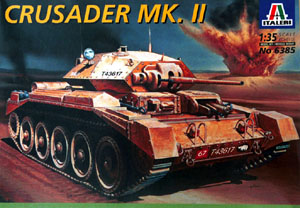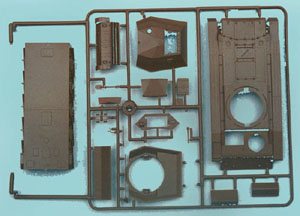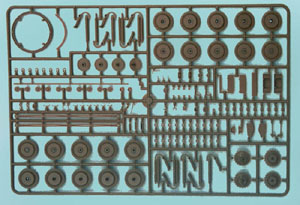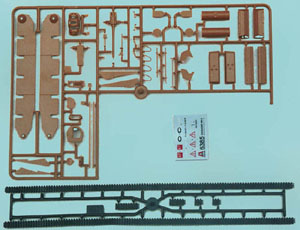Italeri 1/35 British
Crusader Mk. II |  | Background †Think of any wartime newsreel of the Western Desert and you'll no doubt imagine a Crusader tank appearing out of a cloud of dust, pennants flapping in the breeze, all set against a backdrop of burning Axis vehicles. Though good for civilian morale, these images did not portray the whole story. In fact the Crusader- or Cruiser Tank Mk IV A15, to give it its full title - was only lightly armored, and it's puny 40mm two pounder gun was no match for the German Mk III's, though in fairness it was pretty fast, thanks to it's Christie suspension. At that time, British military thinking still revolved around the idea of infantry tanks, slow and heavily armored cruiser tanks, the dashing cavalry scouts, and finally, the heavy tanks, armed with bigger guns for punching through the enemy's strongpoints. And the Crusader definitely fell into the role of a cavalry tank. With its rakish good looks and low, sleek profile, it proved itself to be a reliable steed in the early campaigns, and, along with the Valentine and Matilda, filled the depleted ranks of the 8th Army until the American designed Grants and Shermans could take over. Over time, the extra turret was dropped; various attempts were made to improve the armament, though the odd shaped turret limited the choice of weaponry severely. Finally, towards the end of the war the Chassis and hull were used as a platform for a mobile anti aircraft weapon that saw service throughout the Normandy campaign and beyond.  The Kit The Kit
When I first spotted the kit on the web, I was concerned that Italeri had simply added a new mantlet and an extra turret to their old Crusader Mk. III kit, but on opening the box, I was quickly proved wrong. The box itself is cellophane wrapped, and has a nice illustration of the vehicle on the cover - though I'm not too sure about the red headlight lenses. I know it's been said many times before, but there are no plastic bags for the parts, all of the sprues being loose and unprotected. My advice here is the check carefully if the box has been opened. There are three sprues inside, molded in a rather garish orange plastic, and strangely, they are not lettered, and neither are the parts numbered on the tree. This is not the first time I've noticed this; indeed, the re-released Crusader Mk. III also suffered from the same deficiency. It's not a major problem, just unusual. So, for want of any other way of identifying them, I'll simply say that the first tree holds the wheels, suspension, the turret ring, tow ropes, ammunition boxes and various minor fitting such as handles and the commanderís sight.  The second tree holds the hull top and bottom (mine had broken off, but no damage was done), along with the front and rear hull plates, various boxes and the single piece hatch. As I mentioned earlier, my first impression, that this was a Mk. III with a few extra bits, proved false when I examined the turret top. It has the correct 80-degree angle at the front for the mantlet (the Mk III's turret front is vertical), repositioned periscopes and a correct ventilator dome, and the one-piece hatch that slides rearwards. Indeed, the whole turret conforms very well to Vasko Barbic's excellent drawings that appeared in the October 1992 issue of Military Modelling. The second tree holds the hull top and bottom (mine had broken off, but no damage was done), along with the front and rear hull plates, various boxes and the single piece hatch. As I mentioned earlier, my first impression, that this was a Mk. III with a few extra bits, proved false when I examined the turret top. It has the correct 80-degree angle at the front for the mantlet (the Mk III's turret front is vertical), repositioned periscopes and a correct ventilator dome, and the one-piece hatch that slides rearwards. Indeed, the whole turret conforms very well to Vasko Barbic's excellent drawings that appeared in the October 1992 issue of Military Modelling.
The third tree concerns itself with the hull sides, the new, correct gun mantlet, a new gun, the spare fuel tank and the side boxes. In addition there's the little front turret (ah, memories of my old Airfix 1/72 kit), with a separate, opening half hatch, plus the exhausts, headlight guards, and various tools. Finally, there's a set of flexible tracks, molded in grey vinyl, plus a few spare lengths with which to decorate the finished vehicle.  The markings are rather basic offering only one option. British Army; North Africa, 1940-41. The markings are rather basic offering only one option. British Army; North Africa, 1940-41.
Looking closely at the various components, I have to say that the molding detail is of a fairly high standard, even down to items like screw heads that are clearly visible, and hinges that look pretty much in scale. Only a few of the tool clamps let the kit down, but in truth, I've yet to see an injection molded clamp that wouldn't look better in etched brass. There is no flash to be seen, most of the ejector pin marks will be hidden, and only a few mould lines appear, around such things as the wheels, and this is something that can be removed with a quick wipe of emery. Although I haven't done any proper build-up yet, fit of parts appears good, and, it it's anything like the older Crusader kit, there should be little need for filler. Finally, that strange orange (mustard?) color that hits you hard on first opening the box, should, with hindsight, take a coat of desert sand paint beautifully. The Instruction Sheet The instructions run to 10 pages on a gate folded sheet. The first two pages are taken up with a brief introduction in 11 languages, followed by a page, again in different languages, giving the usual warnings. The next page has a plan of the sprues; this time all numbered, so you can now identify all the bits, plus a painting guide. There are only a couple of unwanted parts, indicating that a fair bit of new tooling has gone into this kit. The twelve stage building instructions are clearly laid out, starting with the wheels and suspension, moving to the hull sides and top, continuing on to the turrets, and finishing off with fitting the tracks. And finally, the painting instructions. Desert sand! Conclusion I have to admit it here and now, I am a British vehicle fan, and deplore the fact that whilst you can now build almost every German tank that ever (and never) was, virtually right out of the box, vehicles from Great Britain and the Commonwealth are ignored by the big manufacturers. Most of my collection (with the exception of Tamiya's recent Cromwell) is made up of kits that were manufactured in the mid - seventies. Therefore, this new version of the Crusader - which has arrived on the scene virtually unannounced - is fantastic news. Indeed, I had toyed with the idea of backdating the Mk. III for ages, but now there's no need. I must also confess that I'm an Italeri fan. True, when you compare like for like, as in the recent Greyhound releases for example, Tamiya and the other Far Eastern companies do have the edge - but at a price! Italeri's Greyhound was 50% cheaper than its rivals, and was still a very good kit for all that. Added to which, the Italians do offer a very eclectic mix of vehicles, and are not being content to simply turn out one King Tiger after another. Take their Buffalo for instance. You get a heck of a lot of plastic for your money, the conversion potential is good, and it's also amazing value. Some of their re- releases such as the old ambulance Jeep and Dodge Weapons Carrier can still produce brilliant models with the application of a little TLC. And let's not forget that newcomers to the hobby can't necessarily afford the high prices being charged for 'top end' kits but may be tempted to have a go at a cheaper model - especially if they can produce a reasonable result. So, in conclusion, a big thank-you to Italeri for this offering. More Allied vehicles - especially soft-skins - please! | 

 



|
